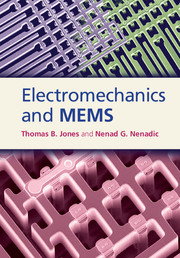Book contents
- Frontmatter
- Contents
- Preface
- 1 Introduction
- 2 Circuit-based modeling
- 3 Capacitive lumped parameter electromechanics
- 4 Small-signal capacitive electromechanical systems
- 5 Capacitive sensing and resonant drive circuits
- 6 Distributed 1-D and 2-D capacitive electromechanical structures
- 7 Practical MEMS devices
- 8 Electromechanics of piezoelectric elements
- 9 Electromechanics of magnetic MEMS devices
- Appendix A Review of quasistatic electromagnetics
- Appendix B Review of mechanical resonators
- Appendix C Micromachining
- Appendix D A brief review of solid mechanics
- Index
- References
7 - Practical MEMS devices
Published online by Cambridge University Press: 05 May 2013
- Frontmatter
- Contents
- Preface
- 1 Introduction
- 2 Circuit-based modeling
- 3 Capacitive lumped parameter electromechanics
- 4 Small-signal capacitive electromechanical systems
- 5 Capacitive sensing and resonant drive circuits
- 6 Distributed 1-D and 2-D capacitive electromechanical structures
- 7 Practical MEMS devices
- 8 Electromechanics of piezoelectric elements
- 9 Electromechanics of magnetic MEMS devices
- Appendix A Review of quasistatic electromagnetics
- Appendix B Review of mechanical resonators
- Appendix C Micromachining
- Appendix D A brief review of solid mechanics
- Index
- References
Summary
Introduction
In the previous chapters, we have investigated lumped parameter electromechanical conversion, linear multiport representations for actuators and sensors, and the effects of external constraints on transducer response. We used a powerful electromechanical analog to synthesize circuit models for transducers, examined the signal conditioning and amplification stages needed to turn MEMS devices into practical systems, and finally developed a methodology to represent mechanical continua, viz., beams and plates, as lumped parameter systems. We are now ready to put these modeling tools to use in the analysis of some practical MEMS devices.
This chapter provides concise system-level technical presentations of four important MEMS applications: pressure sensors, accelerometers, gyroscopes, and energy harvesters. These applications have been selected according to diverse criteria. For example, pressure sensors, relatively uncomplicated as MEMS go, were among the first types of sensors and actuators to be miniaturized. MEMS accelerometers, more complicated than pressure sensors, are very widely used in automotive airbag systems. Micro-mechanical gyroscopes, now available commercially, are considerably more complex than accelerometers, with respect to both the dynamics and the system-level electromechanical drive–sense scheme needed to make them work. Finally, the MEMS energy harvester is included because it is a concept that shows great promise but needs further development before real market penetration can occur.
- Type
- Chapter
- Information
- Electromechanics and MEMS , pp. 298 - 371Publisher: Cambridge University PressPrint publication year: 2013
References
- 1
- Cited by



